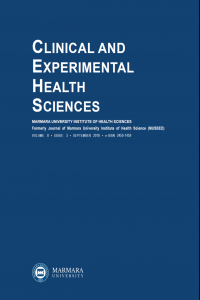Abstract
References
- Lever A, Mackenzie I: Sepsis: definition, epidemiology, and diagnosis. BMJ 2007; 335(7625):879-83.
Nesfatin-1 ameliorates sepsis-induced remote organ injury: The role of oxidant-antioxidant status and neutrophils
Abstract
Purpose: Protective effects of nesfatin-1 was studied in sepsis-induced injury of
remote organs.
Methods: Male rats were randomly divided as control and sepsis (cecal ligationperforation)
groups, treated with either saline or nesfatin-1 (10 μg/kg). At 16 h
following surgery, samples of brain, kidney, liver and lung tissues were removed
and myeloperoxidase (MPO) activity, glutathione (GSH), catalase (CAT), superoxide
dismutase (SOD) and malondialdehyde (MDA) levels were measured in these
tissues.
Results: In saline-treated septic rats, elevated MDA and MPO activities were
accompanied with depleted CAT, SOD and GSH levels in the brain, kidney, liver
and lung tissues, implicating extensive oxidative damage in all remote organs.
Nesfatin-1 reduced MDA levels (brain, lung) and MPO activities (brain, kidney),
and preserved antioxidant GSH (brain, lung), CAT (brain) and SOD (kidney) levels.
Severe hepatocyte degeneration, neuronal damage, glomerulotubular degeneration
and alveolar disturbance in saline-treated septic rats were replaced with regular tissue
morphologies in nesfatin-1-treated rats.
Conclusion: Nesfatin-1 alleviates oxidative damage by enhancing endogenous
antioxidant systems and inhibiting recruitment of neutrophils, suggesting that
nesfatin-1 may be have a potential therapeutic impact on the treatment of septic
shock to reduce subsequent remote organ failure.
Keywords
References
- Lever A, Mackenzie I: Sepsis: definition, epidemiology, and diagnosis. BMJ 2007; 335(7625):879-83.
Details
| Primary Language | English |
|---|---|
| Subjects | Health Care Administration |
| Journal Section | Articles |
| Authors | |
| Publication Date | September 28, 2018 |
| Submission Date | August 20, 2017 |
| Published in Issue | Year 2018 Volume: 8 Issue: 3 |


